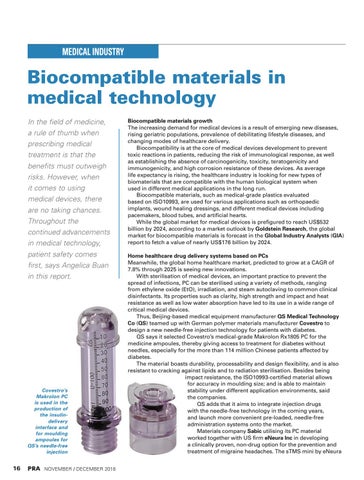Medical Industry
Biocompatible materials in medical technology In the field of medicine, a rule of thumb when prescribing medical treatment is that the benefits must outweigh risks. However, when it comes to using medical devices, there are no taking chances. Throughout the continued advancements in medical technology, patient safety comes first, says Angelica Buan in this report.
Covestro’s Makrolon PC is used in the production of the insulindelivery interface and for moulding ampoules for QS’s needle-free injection
16
NOVEMBER / DECEMBER 2018
Biocompatible materials growth The increasing demand for medical devices is a result of emerging new diseases, rising geriatric populations, prevalence of debilitating lifestyle diseases, and changing modes of healthcare delivery. Biocompatibility is at the core of medical devices development to prevent toxic reactions in patients, reducing the risk of immunological response, as well as establishing the absence of carcinogenicity, toxicity, teratogenicity and immunogenicity, and high corrosion resistance of these devices. As average life expectancy is rising, the healthcare industry is looking for new types of biomaterials that are compatible with the human biological system when used in different medical applications in the long run. Biocompatible materials, such as medical-grade plastics evaluated based on ISO10993, are used for various applications such as orthopaedic implants, wound healing dressings, and different medical devices including pacemakers, blood tubes, and artificial hearts. While the global market for medical devices is prefigured to reach US$532 billion by 2024, according to a market outlook by Goldstein Research, the global market for biocompatible materials is forecast in the Global Industry Analysts (GIA) report to fetch a value of nearly US$176 billion by 2024. Home healthcare drug delivery systems based on PCs Meanwhile, the global home healthcare market, predicted to grow at a CAGR of 7.8% through 2025 is seeing new innovations. With sterilisation of medical devices, an important practice to prevent the spread of infections, PC can be sterilised using a variety of methods, ranging from ethylene oxide (EtO), irradiation, and steam autoclaving to common clinical disinfectants. Its properties such as clarity, high strength and impact and heat resistance as well as low water absorption have led to its use in a wide range of critical medical devices. Thus, Beijing-based medical equipment manufacturer QS Medical Technology Co (QS) teamed up with German polymer materials manufacturer Covestro to design a new needle-free injection technology for patients with diabetes. QS says it selected Covestro’s medical-grade Makrolon Rx1805 PC for the medicine ampoules, thereby giving access to treatment for diabetes without needles, especially for the more than 114 million Chinese patients affected by diabetes. The material boasts durability, processability and design flexibility, and is also resistant to cracking against lipids and to radiation sterilisation. Besides being impact resistance, the ISO10993-certified material allows for accuracy in moulding size; and is able to maintain stability under different application environments, said the companies. QS adds that it aims to integrate injection drugs with the needle-free technology in the coming years, and launch more convenient pre-loaded, needle-free administration systems onto the market. Materials company Sabic utilising its PC material worked together with US firm eNeura Inc in developing a clinically proven, non-drug option for the prevention and treatment of migraine headaches. The sTMS mini by eNeura
